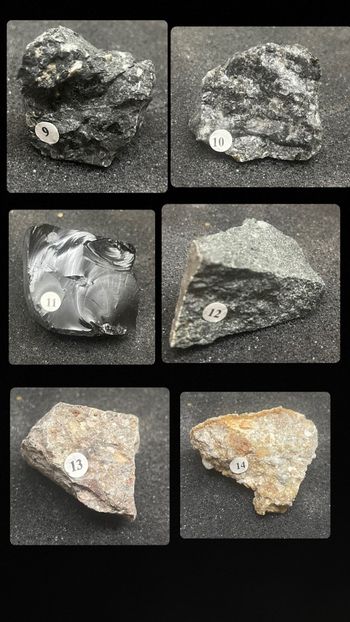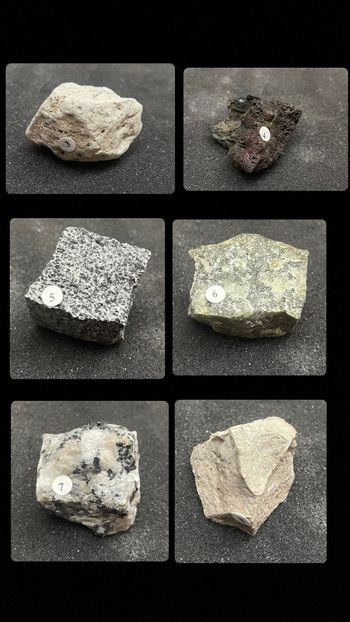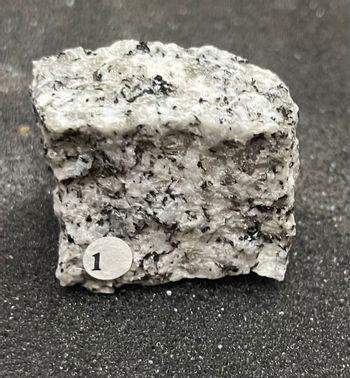10 11 3 b
Applications and Investigations in Earth Science (9th Edition)
9th Edition
ISBN:9780134746241
Author:Edward J. Tarbuck, Frederick K. Lutgens, Dennis G. Tasa
Publisher:Edward J. Tarbuck, Frederick K. Lutgens, Dennis G. Tasa
Chapter1: The Study Of Minerals
Section: Chapter Questions
Problem 1LR
Related questions
Question
what are the name of these minerals 1-12

Transcribed Image Text:This image showcases a collection of twelve mineral specimens, arranged in a 4x3 grid. Each mineral is labeled with a number on a small round sticker for easy identification. Here is a description of each mineral, starting from the top row, left to right:
1. A dark, possibly metallic mineral with a shiny surface.
2. A pyrite-like mineral with cubic crystal formations, exhibiting a metallic luster.
3. A dark mineral with a shiny appearance, possibly hematite.
4. An earthy, reddish-brown mineral, suggesting oxidized material, possibly limonite.
5. A dark, crystalline mineral with a glassy luster, possibly smoky quartz.
6. A translucent, white mineral with a smooth surface, likely selenite.
7. A clear, sheet-like mineral with a shiny texture, possibly mica.
8. A blue mineral with rough texture, likely azurite.
9. A white, somewhat translucent mineral with a blocky structure, possibly calcite.
10. A mineral with a brown tint and smooth, reflective surface, possibly a type of feldspar.
11. A green mineral with a rough surface, possibly serpentine or olivine.
12. A mineral with a rough, grainy texture and mixed earthy tones, possibly jasper.
These specimens provide a variety of textures, colors, and crystal structures, showcasing the diverse characteristics of minerals used for educational purposes.
Expert Solution
This question has been solved!
Explore an expertly crafted, step-by-step solution for a thorough understanding of key concepts.
This is a popular solution!
Trending now
This is a popular solution!
Step by step
Solved in 3 steps

Follow-up Questions
Read through expert solutions to related follow-up questions below.
Follow-up Question
What are the names of these 6 minerals and what are there texture and composition? For each

Transcribed Image Text:The image showcases six rock samples, each labeled with a number on a circular sticker. These samples are presented against a dark background to highlight their features. Here is a detailed description of each rock:
1. **Sample 9**: This rock appears to have a rough texture with a mix of dark and silver hues. It may indicate the presence of minerals that give it a speckled appearance.
2. **Sample 10**: Similar in texture to Sample 9, this rock also exhibits a rugged surface but with a slightly more pronounced silver-gray coloration.
3. **Sample 11**: This rock has a smooth, glassy texture with a black, reflective surface. The distinct swirling pattern suggests it could be a type of volcanic glass, such as obsidian.
4. **Sample 12**: This piece has a triangular shape with a grainy, dark exterior. The texture suggests it may be a type of fine-grained igneous rock.
5. **Sample 13**: Displaying a rough texture and a mix of earthy browns and pinks, this rock seems to have visible grains and pebbles, likely indicative of a sedimentary rock like conglomerate.
6. **Sample 14**: This sample has a sandy brown color with a rough texture, showing a mix of particles. Its appearance suggests it might also be a sedimentary rock.
These samples represent a range of rock types, potentially used for educational purposes to demonstrate the variety in texture, color, and formation processes within geology.
Solution
Follow-up Question
What are the names of these 6 minerals?

Transcribed Image Text:This image features a collection of six different rock samples, each labeled with a unique identifying number on a small circular sticker. These specimens are displayed against a dark surface, allowing for clear examination of their varied textures and colors.
1. **Sample 3**: A light-colored rock with a rough texture. It appears porous with irregular surfaces.
2. **Sample 4**: A darker rock, possibly volcanic in origin, featuring a bumpy and uneven surface. It is darker than sample 3, hinting at a different mineral composition or formation process.
3. **Sample 5**: A speckled rock with a mix of grey and black colors, possibly granite. The even distribution of color speckles suggests a slow cooling history, typical of intrusive igneous rocks.
4. **Sample 6**: This rock has a dull greenish hue, indicating a possible presence of minerals such as chlorite or olivine. Its texture appears more uniform with smaller surface features.
5. **Sample 7**: A rock with a mix of white, pink, and black minerals. The crystal-like features suggest a mineral-rich composition such as feldspar or quartz.
6. **Sample 8**: A pale rock with a smooth and consistent texture. The uniformity of its color and surface might indicate sedimentary origins, suggesting exposure to weathering processes.
These rock samples illustrate the diversity found in geological formations, each with distinct characteristics that reflect their unique histories and mineral compositions.
Solution
Follow-up Question
What are the names of these two minerals?

Transcribed Image Text:The image depicts a rock specimen placed against a textured dark background. It appears to be a rough, irregularly shaped piece of rock with a dark surface, possibly indicating a type of igneous or metamorphic rock. The rock has a coarse texture with visible mineral grains.
Attached to the rock is a small circular label with the number "2" printed on it. This label likely serves as an identifier for educational or cataloging purposes, perhaps corresponding to a specific entry in a geological study or database.
No additional diagrams or graphs accompany the image, focusing solely on the rock sample itself. This kind of presentation is often used in educational settings to visually support lessons on geology, rock classification, or earth sciences.

Transcribed Image Text:This image shows a piece of granite, labeled with a small circular sticker displaying the number "1". The granite has a coarse-grained texture and is primarily light gray, interspersed with darker mineral specks, characteristic of common igneous rocks.
Granite is composed mainly of quartz, feldspar, and mica. The light color is typically due to the presence of feldspar and quartz, while the dark specks are usually biotite or hornblende.
On an educational website, this image could be used to illustrate the texture and appearance of granite, as well as its composition and common uses in construction and sculpture.
Solution
Recommended textbooks for you

Applications and Investigations in Earth Science …
Earth Science
ISBN:
9780134746241
Author:
Edward J. Tarbuck, Frederick K. Lutgens, Dennis G. Tasa
Publisher:
PEARSON

Exercises for Weather & Climate (9th Edition)
Earth Science
ISBN:
9780134041360
Author:
Greg Carbone
Publisher:
PEARSON

Environmental Science
Earth Science
ISBN:
9781260153125
Author:
William P Cunningham Prof., Mary Ann Cunningham Professor
Publisher:
McGraw-Hill Education

Applications and Investigations in Earth Science …
Earth Science
ISBN:
9780134746241
Author:
Edward J. Tarbuck, Frederick K. Lutgens, Dennis G. Tasa
Publisher:
PEARSON

Exercises for Weather & Climate (9th Edition)
Earth Science
ISBN:
9780134041360
Author:
Greg Carbone
Publisher:
PEARSON

Environmental Science
Earth Science
ISBN:
9781260153125
Author:
William P Cunningham Prof., Mary Ann Cunningham Professor
Publisher:
McGraw-Hill Education

Earth Science (15th Edition)
Earth Science
ISBN:
9780134543536
Author:
Edward J. Tarbuck, Frederick K. Lutgens, Dennis G. Tasa
Publisher:
PEARSON

Environmental Science (MindTap Course List)
Earth Science
ISBN:
9781337569613
Author:
G. Tyler Miller, Scott Spoolman
Publisher:
Cengage Learning

Physical Geology
Earth Science
ISBN:
9781259916823
Author:
Plummer, Charles C., CARLSON, Diane H., Hammersley, Lisa
Publisher:
Mcgraw-hill Education,